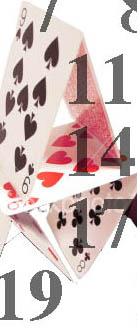
Improvisation/Feedback: “1-2-3…15, 16, 17, NINE-TEEN, 20…”
The point of Yu-gi-oh and of CW is to win, to defeat one’s opponent(s) by taking away their life points, but much of the pleasure of the game is in the anticipation of knowing whether, in a given turn, one has edged out the opposing forces, and figuring this out is a process of computing what the cards say. In CW, Oliver takes his time doing this and what his body tells me is that he relishes every moment of this math (“I do 100, 104, 100,000 damage to your lifepoints), even to the degree (and this is where CW becomes distinct from Yu-gi-oh and its own semiotic domain) that Oliver improvises the game’s rules (“Dang: we both won”). After one particularly long computation, Oliver seems to realize that he’s taken away too many lifepoints from me and declares, “Just kidding. I can’t attack anymore.”
Oliver’s learning in Yu-gi-oh and CW is embodied because it is as much about fashioning himself after an example (his brother) as it is experimentating with what it means to play (any) game. Gee explains that active learning in game playing often follows the “probe-hypothesize-reprobe-rethink” cycle as a learner “feels” her way through an environment. Gee defines the distinct facets of this experimental body learning forth in a video game environment:
- the player must probe the virtual world (which involves looking around the current environment, clicking on something, or engaging in a certain action)
- based on reflection while probing and afterward, the player must form a hypothesis about what something (a text, object, artifact, event, or action) might mean in a usefully situated way
- the player reprobes the world with that hypothesis in mind, seeing what effect he or she gets
- the player treats this effect as feedback from the world and accepts or rethinks his or her original hypothesis. (90)
Oliver’s improvisation is not, like adult improvisation, an attempt to access his creative side and be in the moment; it is probing, trying out ideas and, after registering what they feel like, deciding what the game of CW should be.
One: Situating Embodied Learning
-
Identity and Learning: “Follow What I Am Doing: Do The Rules That I’m Doing: It’s Very CoM-pli-cated”
- Producelike Behavior: "Why Do The Make Queen Better Than Jack?"
- Conclusion: "The Bricolage, The Music, The Movement"
Three: Implications for the Literacy Autobiography Assignment
